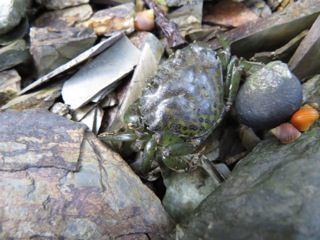 If you’ve ever found a crab when rock-pooling, there’s every chance it was a Shore Crab.
If you’ve ever found a crab when rock-pooling, there’s every chance it was a Shore Crab.
Photo: Ray Surridge
Scientific name: Carcinus maenas
Cornish name: The general word for crab is kanker
Other common names: Green Shore Crab, Common Shore Crab
Conservation status: This is a very common crab of the seashore in Britain
 A very common rock-pooling find, the Shore Crab Carcinus maenas can be found round the British shoreline, and is particularly abundant in estuaries and salt marshes. Predominantly olive-green in colouring, individuals can also have brown and reddish patterning, and younger specimens, which show a particularly wide variability in mottled patterning, may have white markings. As well as its colouring, identifying features of this small- to medium-sized crab (≤10 cm) also include the pincers on the first pair of walking legs and the serrated edge of the front of its carapace, which is also broader than it is long.
A very common rock-pooling find, the Shore Crab Carcinus maenas can be found round the British shoreline, and is particularly abundant in estuaries and salt marshes. Predominantly olive-green in colouring, individuals can also have brown and reddish patterning, and younger specimens, which show a particularly wide variability in mottled patterning, may have white markings. As well as its colouring, identifying features of this small- to medium-sized crab (≤10 cm) also include the pincers on the first pair of walking legs and the serrated edge of the front of its carapace, which is also broader than it is long.
A male Shore Crab can only mate with the female just after the latter has moulted. The male will ‘lay claim’ to a female that is about to moult and carry her beneath him until she is ready for breeding. The females lay their eggs and then carry them on their legs (called being ‘in berry’) for many months. The newly-hatched larvae live as plankton for two to three years before maturing into crabs.
They might not be especially large, but Shore Crabs are an aggressive species with a fairly wide diet, including worms, smaller crabs, detritus and algae. In the Victoria County History of Cornwall, the Rev. T.R.R. Stebbing (quoted in Turk, 1971, p. 59), describes this species as being valued for its “abundance, effrontery, hardihood and handiness…Nothing scares it.”
Did you know…?
…A native of the eastern shores of the North Atlantic Ocean and of the Mediterranean, Shore Crabs have been introduced to Australia and the USA, where they have become an invasive species.
…Small but fierce: they fight each other, and several Shore Crabs in each population have only one claw as a result of injury.
More information and references:
Turk, S.M., 1971. Seashore Life in Cornwall and the Isles of Scilly. D. Bradford Barton Ltd., Truro, Cornwall.
Published: August 2013
Author: Amanda Scott
Photos: Ray Surridge
